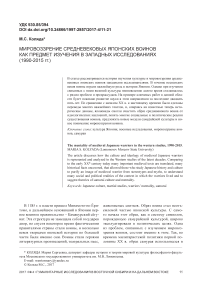Мировоззрение средневековых японских воинов как предмет изучения в западных исследованиях (1990-2015 гг.)
Автор: Коляда Мария Сергеевна
Журнал: Гуманитарные исследования в Восточной Сибири и на Дальнем Востоке @gisdv
Рубрика: История и культура Востока
Статья в выпуске: 4 (42), 2017 года.
Бесплатный доступ
В статье рассматривается история изучения культуры и мировоззрения средневековых японских воинов западными исследователями. В течение нескольких веков воины играли важнейшую роль в истории Японии. Однако при изучении связанных с ними явлений культуры японоведение долгое время сталкивалось с рядом проблем и предрассудков. На примере ключевых работ в данной области будет показано развитие науки в этом направлении за последние двадцать пять лет. По сравнению с началом XX в. к настоящему времени были сделаны переводы многих важнейших текстов, и, опираясь на известные теперь исторические данные, японоведы смогли очистить образ средневекового воина от идеологических наслоений, понять многие социальные и политические реалии существования воинов, предложить новые модели самурайской культуры и новое понимание мировоззрения воинов.
Культура японии, военные исследования, мировоззрение воинов, самураи
Короткий адрес: https://sciup.org/170175732
IDR: 170175732 | DOI: 10.24866/1997-2857/2017-4/11-21
Список литературы Мировоззрение средневековых японских воинов как предмет изучения в западных исследованиях (1990-2015 гг.)
- Госэйбай сикимоку//Восточная литература . -Режим доступа: http://www.vostlit.info/Texts/Dokumenty/Japan/XIII/1220-1240/Gosejbaj_sikimoku/text.phtml?id=11640
- Книга самурая: Юдзан Дайдодзи. Будосёсинсю. Ямамото Цунэтомо. Хагакурэ. Юкио Мисима. Хагакурэ Нюмон/Пер. Котенко Р.В., Мищенко А.А. СПб.: Евразия, 1998.
- Мещеряков А.Н. Быть японцем: история, политика и сценография японского милитаризма. М.: Наталис, 2009.
- Мещеряков А.Н., Грачев М.В. История древней Японии. М.: Наталис, 2010.
- Накамура Кооя. История Японии//История Японии. Сборник исторических произведений. М.: Русская панорама, 2010. С. 349-388.
- Повесть о смуте годов Хэйдзи/Пер. Онищенко В.А. СПб.: Гиперион, 2011.
- Трубникова Н.Н., Бабкова М.В. Обновление традиций в японской религиозно-философской мысли XIII-XIV вв. М.: Политическая энциклопедия, 2014.
- Хогэн моногатари -Сказание о годах Хогэн/Пер. Горегляд В.Н. СПб.: Гиперион, 1999.
- Ходзё Сигэтоки. Наставления господина Гокуракудзи/Пер. Коляда М.С.//Вопросы философии. 2017. № 6. С. 155-182.
- Adolphson, M.S., 2000. The gates of power: monks, courtiers, and warriors in premodern Japan. Honolulu: University of Hawaii Press.
- Bary, T. et al. eds., 2010. Sources of Japanese tradition, Vol. 1: From earliest times to 1600. New York: Columbia University Press.
- Blomberg, C., 2013. The heart of the warrior: origins and religious background of the samurai system in feudal Japan. London: Routledge.
- Collcut, M., 1996. Religion in life of Minamoto Yoritomo and the early bakufu. In: Kornicki, P.F. and McMullen, I.J. eds., 1996. Religion in Japan: arrows to heaven and earth. Cambridge: Cambridge University Press.
- Conlan, T.D., 2000. The culture of force and farce: fourteenth-century Japanese warfare. Cambridge: Reischauer Institute of Japanese Studies.
- Conlan, T.D., 2001. In little need of divine intervention: Takezaki Suenaga's scrolls of the Mongol invasions of Japan. New York: East Asia Program, Cornell University.
- Farris, W., 1995. Heavenly warriors: the evolution of Japan’s military, 500-1300. Cambridge: Harvard University Press.
- Friday, K., 1994. Bushido or bull? A medieval historian's perspective on the imperial army and the Japanese warrior tradition. The History Teacher, Vol. 27, no. 3, pp. 339-349.
- Friday, K., 2004. Samurai, warfare and the state in early medieval Japan. New York: Routledge.
- Friday, K., 2006. Might makes right. Just war and just warfare in early medieval Japan. In: Brekke, T. ed., 2006. The ethics of war in Asian civilizations: a comparative perspective. London: Routledge, pp. 159-184.
- Hall, D., 2013. The Buddhist goddess Marishiten: a study of the evolution and impact of her cult on the Japanese warrior. Leiden: Brill.
- Hogen monogatari: tale of the disorder in Hogen. A Monumenta Nipponica Monograph. Tokyo: Sophia University, 1971.
- Ikegami Eiko, 1995. The taming of the samurai: honorific individualism and the making of modern Japan. Cambridge: Harvard University Press.
- Inazao Nitobe, 2005. Bushido: the spirit of the samurai. Colorado: Shambhala.
- Mass, J., 1974. Warrior government in early medieval Japan: a study of the Kamakura Bakufu, Shugo and Jito. New Haven: Yale University Press.
- Mass, J.P. ed., 1997. The origins of Japan’s medieval world: courtiers, clerics, warriors, and peasants in the fourteenth century. Stanford: Stanford University Press.
- Mishima Yukio, 1977. The way of the samurai: Yukio Mishima on Hagakure in modern life. New York: Basic Books.
- Oyler, E., 2006. Swords, oaths, and prophetic visions: authoring warrior rule in medieval Japan. Honolulu: University of Hawaii Press.
- Steenstrup, C., 1979. Hojo Shigetoki (11981261) and his role in the history of political and ethical ideas in Japan. London, Malmö: Curson Press Ltd.
- The Heike Monogatari. Transactions of the Asiatic Society of Japan, 1918, Vol. 46, no. 2, pp. 1-278; 1921, Vol. 49, no. 1, pp. 1-354.
- The Taiheiki: a chronicle of medieval Japan. Vermont: Tuttle Publishing, 1979.
- The tale of Heiji. Harvard: Harvard University, 1969.
- Varley, H.P., 1994. Warriors of Japan: as portrayed in the war tales. Honolulu: University of Hawaii Press.
- Yamamoto Tsunetomo, 1979. Hagakure: the book of the samurai. Tokyo: Kondansha International Ltd.
- Yūzan Daidōji, 1984. Budoshoshinshu. Santa Clarita: Ohara Books.


